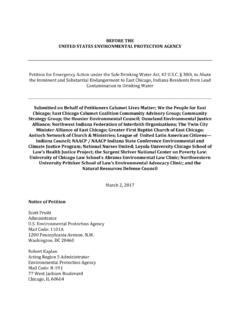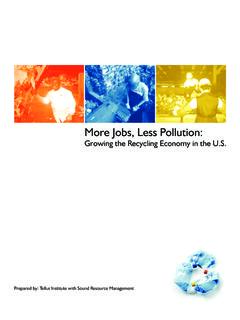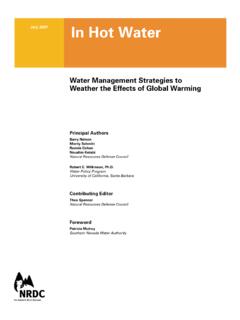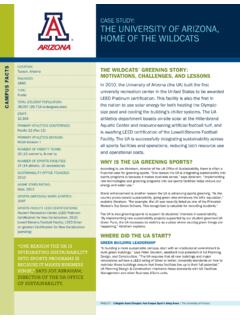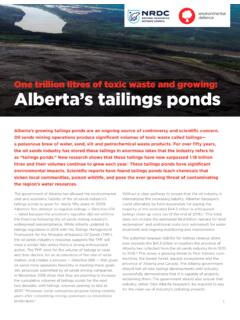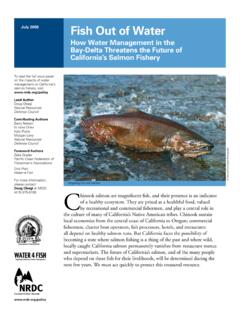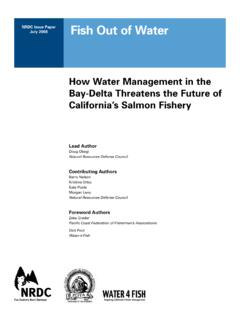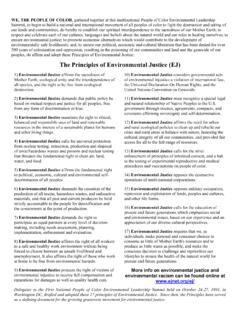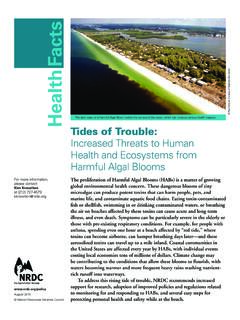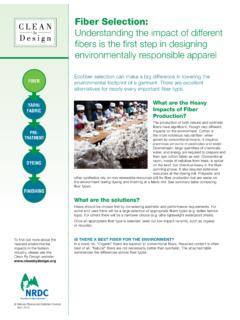Transcription of The Impacts of Beach Pollution - Natural Resources Defense ...
1 Jon Beach water makes swimmers sick and hurts coastal economies. Illnesses associated with polluted Beach water include stomach flu, skin rashes, pinkeye, respiratory infections, meningitis, and hepatitis. In addition to the health effects of polluted Beach water, there may be deep financial Impacts as well. Economists have estimated that a typical swimming day is worth approximately $35 for each Beach visitor, so the economic loss for each day on which a Beach is closed or under advisory for water quality problems can be quite the waters 24th EdItIonThe Impacts of Beach PollutionFor more information,please risksDiseases Caused by Pathogens in Bathing watersPolluted waters may contain disease -causing organisms called pathogens.
2 The most common types of pathogens bacteria, viruses, and protozoa are those associated with human and animal waste. For instance, giardiasis is caused by the protozoan Giardia lambia, North America s leading reported intestinal Swimmers in sewage-polluted water can contract any illness that is spread by fecal contact, including stomach flu, respiratory infection, and ear and skin infections. Most swimming-related illnesses last from a few days to several weeks, but in some cases pathogens may cause severe, long-term illness or even death.
3 Sensitive populations such as children, the elderly, or those with a weakened immune system are particularly at risk for long-term effects. For example, research has shown that children under the age of nine have more reports of diarrhea and vomiting from exposure to waterborne pathogens than any other age group, with at least a twofold increase occurring over the summer swimming There is usually a delay of several days to two weeks between contact with contaminated water and expression of symptoms, and most people who get sick from swimming are not aware of the link.
4 Beachgoers can even become ill without going in the water. A 2009 study found a positive association between Beach sand contact and the risk of gastrointestinal illness at beaches near a sewage treatment plant the basis of Beach visitation rates and monitoring data, researchers have estimated that 689,000 to 4,003,000 instances of gastrointestinal illness and 693,000 instances of respiratory illness occurred each year between 2000 and 2004 at Southern California While these estimates are subject to a great deal of uncertainty.
5 They provide insight into the potential for underreporting of such illnesses. Contaminated runoff and incidence of DiseaseDischarges of polluted urban runoff result in elevated bacteria levels and increased illness rates among swimmers, and the association between heavy precipitation (leading to increased runoff ) and waterborne disease outbreaks is well For instance, a 2012 California study investigated surfers risk of contracting gastrointestinal illness during dry weather and in post-storm conditions in the coastal waters of Southern California based on enterococcus and fecal coliform concentrations in the water.
6 The researchers found that at most beaches, there are higher GI risks after rainfall than during dry condition[s] and that some beaches have significantly elevated health risks for surfers after a storm event. 6A large-scale 1995 epidemiological study, also in California, investigated possible adverse health effects of swimming in ocean waters contaminated by urban The study found an increased risk of illness associated with swimming near flowing storm drain outlets in Santa Monica Bay, compared with swimming more than 400 yards away.
7 Swimmers near storm drains were found to have a 57 percent greater incidence of fever, for instance, than those swimming farther supports a variety of solutions to Beach Pollution from contaminated runoff including the use of permeable pavement and the installation of rain gardens to reduce runoff volume. To learn more, see Community Measures to Prevent Beach and Ocean Pollution on our Smarter Living page. Climate Change and incidence of DiseaseClimate change is expected to increase the incidence of diseases contracted by swimmers.
8 Recreational waters located in areas where climate change causes increased precipitation and runoff are more likely to become contaminated with pathogens such as Cryptosporidium parvum and Giardia lambia, which are associated with polluted runoff and combined sewer overflows. An article in Climate Research notes that, although there are uncertainties, a wetter climate in the [mid-Atlantic region] could lead to higher [Cryptosporidium] loads in water. 8 A major cryptosporidiosis outbreak in Milwaukee in 1993 killed 54 people and sickened more than 400,000 after stormwater compromised the performance of a drinking water treatment The bacterium Vibrio cholerae , which causes cholera, is another pathogen that presents an increased threat to humans as a result of climate change.
9 Extreme weather events and warmer waters can foster growth of the bacterium; one study found that V. cholerae was nearly 20 times more likely to occur at a temperature of F or higher than at lower Increased freshwater runoff, high in nutrients and low in salinity, also may favor the growth of V. cholerae . As one study of Chesapeake Bay concluded, Increased climate variability, accompanied by higher stream flow rates and warmer temperatures, could favor conditions that increase the occurrence of V. cholera in Chesapeake Bay.
10 11threats to swimmers from harmful algal BloomsHarmful algal blooms (HABs), often called red tides, are a growing problem in surface waters where nutrient-rich Pollution can spur algal growth. Several species of phytoplankton produce potent toxins that can make people sick if they are exposed to contaminated water or if they eat contaminated fish or shellfish. These organisms are a Natural part of the ocean ecosystem, but when conditions are right, they experience a rapid growth in number, resulting in a bloom.
